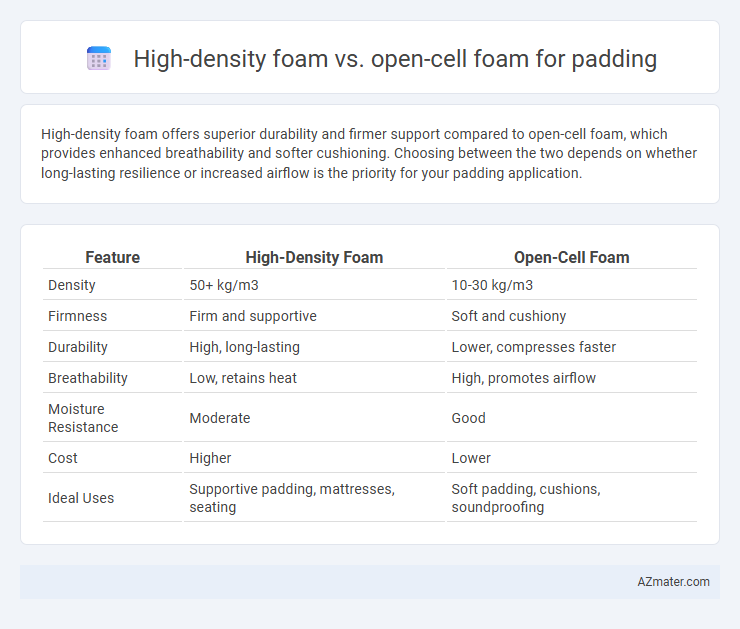High-density foam offers superior durability and firmer support compared to open-cell foam, which provides enhanced breathability and softer cushioning. Choosing between the two depends on whether long-lasting resilience or increased airflow is the priority for your padding application.
Table of Comparison
| Feature | High-Density Foam | Open-Cell Foam |
|---|---|---|
| Density | 50+ kg/m3 | 10-30 kg/m3 |
| Firmness | Firm and supportive | Soft and cushiony |
| Durability | High, long-lasting | Lower, compresses faster |
| Breathability | Low, retains heat | High, promotes airflow |
| Moisture Resistance | Moderate | Good |
| Cost | Higher | Lower |
| Ideal Uses | Supportive padding, mattresses, seating | Soft padding, cushions, soundproofing |
Introduction to Foam Types for Padding
High-density foam offers superior durability and support, making it ideal for long-lasting padding in furniture and mattresses, as it resists compression and retains shape over time. Open-cell foam features a breathable, flexible structure with interconnected air pockets, providing enhanced ventilation and softer cushioning suitable for comfort-focused applications. Choosing between high-density and open-cell foam depends on the specific requirements for firmness, breathability, and longevity in padding materials.
What is High-Density Foam?
High-density foam is a type of polyurethane foam characterized by its greater mass per cubic foot, typically above 2.5 pounds, providing superior durability and support compared to open-cell foam. It features a tightly packed cell structure, which enhances its firmness and resistance to compression, making it ideal for high-traffic areas and long-lasting padding applications. This foam's high density also contributes to better load distribution and improved comfort in furniture cushions and mattress toppers.
What is Open-Cell Foam?
Open-cell foam is a lightweight, flexible material characterized by its porous structure where cells are intentionally left open, allowing air to fill the spaces. This type of foam offers excellent breathability and cushioning, making it ideal for padding applications that require softness and pressure relief. Compared to high-density foam, open-cell foam provides enhanced airflow and moisture control, promoting comfort and reducing heat retention.
Key Differences: High-Density vs Open-Cell Foam
High-density foam offers superior durability and firm support due to its tightly packed cells, making it ideal for heavy-use furniture and sports padding. Open-cell foam features a softer, more breathable structure with interconnected cells that provide enhanced airflow and cushioning, suited for comfort-focused applications like mattresses and seat cushions. The key differences lie in density, firmness, longevity, and breathability, influencing the choice between durability and softness in padding materials.
Comfort and Support Comparison
High-density foam provides superior support and firmness due to its tightly packed cell structure, making it ideal for applications requiring consistent pressure distribution and durability. Open-cell foam offers enhanced breathability and softness, delivering a plush comfort experience by allowing air to circulate freely, which reduces heat retention. For padding, high-density foam excels in long-term support and shape retention, whereas open-cell foam prioritizes cushioning comfort and ventilation.
Durability and Longevity Factors
High-density foam offers superior durability and longevity compared to open-cell foam due to its compact cell structure, which resists compression and maintains shape over time. Open-cell foam is softer and more breathable but tends to break down faster under prolonged use, leading to reduced cushioning performance. For padding applications requiring extended lifespan and sustained support, high-density foam is the preferred choice.
Breathability and Moisture Resistance
High-density foam offers superior moisture resistance due to its denser structure, making it less prone to water absorption and ideal for environments requiring durability and longevity. Open-cell foam excels in breathability thanks to its interconnected air pockets, promoting airflow and cooling, but it tends to retain moisture, which can lead to mold and degradation over time. Choosing between the two depends on whether breathability or moisture resistance is the priority in padding applications such as cushions, mattresses, or protective gear.
Cost and Affordability Analysis
High-density foam typically costs more upfront due to its denser material composition, offering durable and long-lasting padding ideal for heavy use. Open-cell foam is generally more affordable and provides excellent breathability but may compress faster, requiring more frequent replacement. When evaluating cost-effectiveness, high-density foam's durability can offset its initial price through extended lifespan, whereas open-cell foam suits budget-conscious buyers needing softer cushioning at lower prices.
Ideal Applications for Each Foam Type
High-density foam offers excellent support and durability, making it ideal for applications such as seat cushions, mattresses, and gym equipment padding where long-term resilience is crucial. Open-cell foam, known for its softness and breathability, is better suited for sound insulation, upholstering furniture, and lightweight cushioning in pillows or packaging. Selecting the right foam depends on balancing factors like support requirements, airflow needs, and the specific use environment.
Which Foam is Best for Your Padding Needs?
High-density foam offers superior durability and support, making it ideal for long-term cushioning in furniture and mattresses, while open-cell foam provides better breathability and softer comfort suitable for pillows and lighter padding applications. For optimal padding needs, high-density foam is best when structural integrity and resilience are priorities, whereas open-cell foam excels in providing enhanced airflow and a gentler feel. Choosing the right foam depends on the balance between firmness, longevity, and ventilation required for your specific use.

Infographic: High-density foam vs Open-cell foam for Padding
 azmater.com
azmater.com